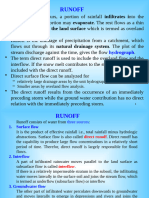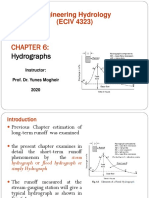Report sample HYDRO
Uploaded by
rtikyadav85Report sample HYDRO
Uploaded by
rtikyadav85RUNOFF 21CV51
INTRODUCTION
Runoff refers to the movement of water over the land surface or through the
subsurface towards streams, rivers, lakes, and oceans. It occurs when
precipitation, such as rain, snow, or sleet, exceeds the infiltration capacity of the
soil or the ability of the ground to absorb water. Runoff can originate from
various sources, including rainfall, snowmelt, or ice melt.
It seems like you want the information formatted in a PowerPoint slide. Here's
how you can structure it:
Factors Affecting Runoff:
1.Precipitation:
- Amount, intensity, duration, and spatial distribution impact runoff.
- Heavy rainfall or prolonged events increase runoff.
2. Characteristics:
- Texture, structure, compaction, porosity, and permeability influence infiltration.
- Sandy soils allow faster infiltration; clayey soils produce more runoff.
3. Vegetation Cover:
- Intercepts rainfall, reduces impact, and enhances soil structure.
- Dense cover reduces runoff by promoting absorption and reducing erosion.
4. Topography:
- Slope gradient, length, and shape influence runoff velocity and direction.
- Steeper slopes generate higher runoff volumes.
5. Land Use and Land Cover:
- Urbanization, deforestation, and agriculture modify runoff characteristics.
- Changes alter surface permeability and natural drainage patterns.
6. Antecedent Moisture Conditions:
Department of Civil Engineering Page 1
RUNOFF 21CV51
- Soil moisture before precipitation events affects infiltration and runoff.
7. Climate:
- Temperature, humidity, wind, and seasonal variations affect precipitation types and
patterns.
- Influence runoff through their impact on precipitation.
Hydrograph:
A hydrograph is a graph showing the rate of flow (discharge) versus time past a
specific point in a river, channel, or conduit carrying flow
Components of Hydrograph:
A hydrograph is a graphical representation of the discharge (flow) of a river or stream over
time, typically following a rainfall event or snowmelt. It consists of several key components:
1.Rising Limb: The rising limb of a hydrograph represents the initial increase in discharge
following the onset of precipitation or snowmelt. During this phase, runoff from the
catchment area begins to enter the river or stream, causing the water level and discharge to
rise.
2.Peak Flow: The peak flow is the highest discharge observed during the hydrograph. It
occurs when the runoff from the catchment area reaches its maximum rate, typically as a
result of intense rainfall or rapid snowmelt. The peak flow often corresponds to the peak of
the storm or melting event.
3.Recession Limb: The recession limb of a hydrograph represents the gradual decrease in
discharge following the peak flow. As precipitation diminishes or snowmelt slows down, the
amount of runoff entering the river or stream decreases, causing the water level and discharge
to decline over time.
4.Baseflow: Baseflow represents the portion of streamflow that is sustained by groundwater
sources rather than direct runoff from precipitation or snowmelt. It typically forms a
Department of Civil Engineering Page 2
RUNOFF 21CV51
relatively constant, low-level component of the hydrograph, contributing to streamflow
during dry periods between rainfall events.
5.Time to Peak: The time to peak refers to the duration between the onset of precipitation or
snowmelt and the occurrence of the peak flow in the hydrograph. It reflects the time it takes
for runoff from the catchment area to travel through the watershed and reach the river or
stream.
6. Recession Period: The recession period is the duration over which discharge gradually
decreases following the peak flow. It indicates how quickly the river or stream returns to its
normal flow conditions after the cessation of precipitation or snowmelt.
Methods of Baseflow separation:
Mainly following three methods are used for baseflow separation.
Straight Line Method: In this method the separation of the base flow is achieved by joining
with a straight line the beginning of the surface runoff to a point on the recession limb
representing the end of the direct runoff. In Fig. 1, point A represents the beginning of the
direct runoff off and it is usually easy to identify in view of the sharp change in the runoff
rate at that point. Point B, marking the end of the direct runoff is rather difficult to locate
exactly.
Department of Civil Engineering Page 3
RUNOFF 21CV51
Fig. 1. Straight Line Method for base flow separation
Fixed Base Method:
In this method the base flow curve existing prior to the commencement of the surface runoff
is extended till it intersects the ordinate drawn at the peak (point C in Fig. 2). This point is
joined to point B by a straight line. Segment AC and CB demarcate the base flow and surface
runoff. This is probably the most widely used base-flow separation procedure.
Fig. 2. Fixed Base Method for base flow separation.
3. Variable Slope Method
In this method the base flow recession curve after the depletion of the flood water is
extended backwards till it intersects the ordinate at the point of inflection (line EF in Fig.
3). Points A and F are joined by an arbitrary smooth curve. This method of base-flow
separation is realistic in The surface runoff hydrograph obtained after the base-flow
separation is also known as direct runoff hydrograph (DRH).
Department of Civil Engineering Page 4
RUNOFF 21CV51
Fig. 3. Variable Slope Method for base flow separation
Unit Hydrograph:
A unit hydrograph represents the response of a watershed to a unit input
of rainfall over a specific duration. In simpler terms, it describes how a
certain amount of rainfall is transformed into runoff over time in a
particular watershed.
Assumption of unit hydrograph:
Rainfall is assumed to be uniform over the watershed.
1. The rainfall duration is fixed.
2. The watershed response is linear and time-invariant.
3. There is no change in the storage of water in the watershed during the rainfall
event.
4. The unit hydrograph derived for one storm event can be used to predict the
response for similar storm events.
Limitation of hydrograph:
i)Unit hydrograph method is not applicable to areas with a major portion of storm
precipitation being on form of snow.
ii)Principle of time in-variance sometimes does not hold as the basin characteristics
will chabge with man made adjustments as well as seasons.
iii)The linearity principle is strictly valid since unit hydrographs derived from small
rainfall events generally has lower peaks than those derived from more larger
storms.
Department of Civil Engineering Page 5
RUNOFF 21CV51
iv)The storms that are selected should always be of short duration due to uniform
rainfall intensity.
‘S’ curve method:
If we have to develop a unit hydrograph of m D duration. where m is a
fraction, the method of superposition can’t be used. It is the hydrograph
obtained by summation of an infinite series of D-h apart. At any given
time the ordinates of the various curves occurring at that time coordinates
are summed up to obtain ordinates of s-curve. The smooth curve through
these ordinates results in an S-shaped curve.The S-hydrograph is a
continuously rising curve that ultimately attains a constant value when
equilibrium is reached.
Department of Civil Engineering Page 6
You might also like
- Hydrologic Analysis (Hydrograph Analysis) Week 8No ratings yetHydrologic Analysis (Hydrograph Analysis) Week 841 pages
- Group 07 - Rainfall-runoff Reationship 20250308 091207 0000 CompressedNo ratings yetGroup 07 - Rainfall-runoff Reationship 20250308 091207 0000 Compressed31 pages
- G-6-RAINFALL-RUNOFF-RELATION_Lessson-6_HYDROLOGY-1No ratings yetG-6-RAINFALL-RUNOFF-RELATION_Lessson-6_HYDROLOGY-125 pages
- UNIT-3-RUNOFF-HYDROGRAPH NOTES-MERGED (1)-CopyNo ratings yetUNIT-3-RUNOFF-HYDROGRAPH NOTES-MERGED (1)-Copy26 pages
- Module 2-Hydrology and Irrigation EngineeringNo ratings yetModule 2-Hydrology and Irrigation Engineering7 pages
- Runoff: Ground Water Runoff/ Ground Water Flow Runoff Characteristics On Streams ClassificationNo ratings yetRunoff: Ground Water Runoff/ Ground Water Flow Runoff Characteristics On Streams Classification4 pages
- Group 6 - Runoff Calculation (Rational Method)No ratings yetGroup 6 - Runoff Calculation (Rational Method)19 pages
- Hydrographs: Engineering Hydrology (ECIV 4323)50% (2)Hydrographs: Engineering Hydrology (ECIV 4323)46 pages
- Unit 7-Introduction To Hydrograph AnalysisNo ratings yetUnit 7-Introduction To Hydrograph Analysis27 pages
- Terrestrial Water Cycle and Climate Change: Natural and Human-Induced ImpactsFrom EverandTerrestrial Water Cycle and Climate Change: Natural and Human-Induced ImpactsQiuhong TangNo ratings yet
- Dying A Social Perspective On The End of Life Alex Broom Download PDF100% (8)Dying A Social Perspective On The End of Life Alex Broom Download PDF65 pages
- Bethke, Bruce & Day, Vox - Rebel Moon (1416501908) PDFNo ratings yetBethke, Bruce & Day, Vox - Rebel Moon (1416501908) PDF147 pages
- 571470-29 Linear Encoders For Numerically Controlled Machine ToolsNo ratings yet571470-29 Linear Encoders For Numerically Controlled Machine Tools60 pages
- History of Philadelphia International AirportNo ratings yetHistory of Philadelphia International Airport3 pages
- HDFC Bank Millennia Credit Card: Inspired Living, Ready For YouNo ratings yetHDFC Bank Millennia Credit Card: Inspired Living, Ready For You3 pages
- Development Programs in S&T in The PhilippinesNo ratings yetDevelopment Programs in S&T in The Philippines3 pages
- Instant Access to Emotions as Original Existences: A Theory of Emotion, Motivation and the Self 1st ed. Edition Demian Whiting ebook Full ChaptersNo ratings yetInstant Access to Emotions as Original Existences: A Theory of Emotion, Motivation and the Self 1st ed. Edition Demian Whiting ebook Full Chapters41 pages
- Chemistry Criterion D: Chemical Compounds in Daily Life 1No ratings yetChemistry Criterion D: Chemical Compounds in Daily Life 13 pages
- Critical Success Factors in Projects PinNo ratings yetCritical Success Factors in Projects Pin20 pages
- HUDCC Guidelines For Identification of Lots and Sites For Socialized HousingNo ratings yetHUDCC Guidelines For Identification of Lots and Sites For Socialized Housing6 pages
- The Demonic King Chases His Wife - Chapter 351-400No ratings yetThe Demonic King Chases His Wife - Chapter 351-400119 pages
- Diversey Suma Multi d2 3l Cleaner ConcentrateNo ratings yetDiversey Suma Multi d2 3l Cleaner Concentrate2 pages
- Group 07 - Rainfall-runoff Reationship 20250308 091207 0000 CompressedGroup 07 - Rainfall-runoff Reationship 20250308 091207 0000 Compressed
- G-6-RAINFALL-RUNOFF-RELATION_Lessson-6_HYDROLOGY-1G-6-RAINFALL-RUNOFF-RELATION_Lessson-6_HYDROLOGY-1
- Runoff: Ground Water Runoff/ Ground Water Flow Runoff Characteristics On Streams ClassificationRunoff: Ground Water Runoff/ Ground Water Flow Runoff Characteristics On Streams Classification
- Terrestrial Water Cycle and Climate Change: Natural and Human-Induced ImpactsFrom EverandTerrestrial Water Cycle and Climate Change: Natural and Human-Induced Impacts
- Dying A Social Perspective On The End of Life Alex Broom Download PDFDying A Social Perspective On The End of Life Alex Broom Download PDF
- Bethke, Bruce & Day, Vox - Rebel Moon (1416501908) PDFBethke, Bruce & Day, Vox - Rebel Moon (1416501908) PDF
- 571470-29 Linear Encoders For Numerically Controlled Machine Tools571470-29 Linear Encoders For Numerically Controlled Machine Tools
- HDFC Bank Millennia Credit Card: Inspired Living, Ready For YouHDFC Bank Millennia Credit Card: Inspired Living, Ready For You
- Instant Access to Emotions as Original Existences: A Theory of Emotion, Motivation and the Self 1st ed. Edition Demian Whiting ebook Full ChaptersInstant Access to Emotions as Original Existences: A Theory of Emotion, Motivation and the Self 1st ed. Edition Demian Whiting ebook Full Chapters
- Chemistry Criterion D: Chemical Compounds in Daily Life 1Chemistry Criterion D: Chemical Compounds in Daily Life 1
- HUDCC Guidelines For Identification of Lots and Sites For Socialized HousingHUDCC Guidelines For Identification of Lots and Sites For Socialized Housing
- The Demonic King Chases His Wife - Chapter 351-400The Demonic King Chases His Wife - Chapter 351-400

























































































